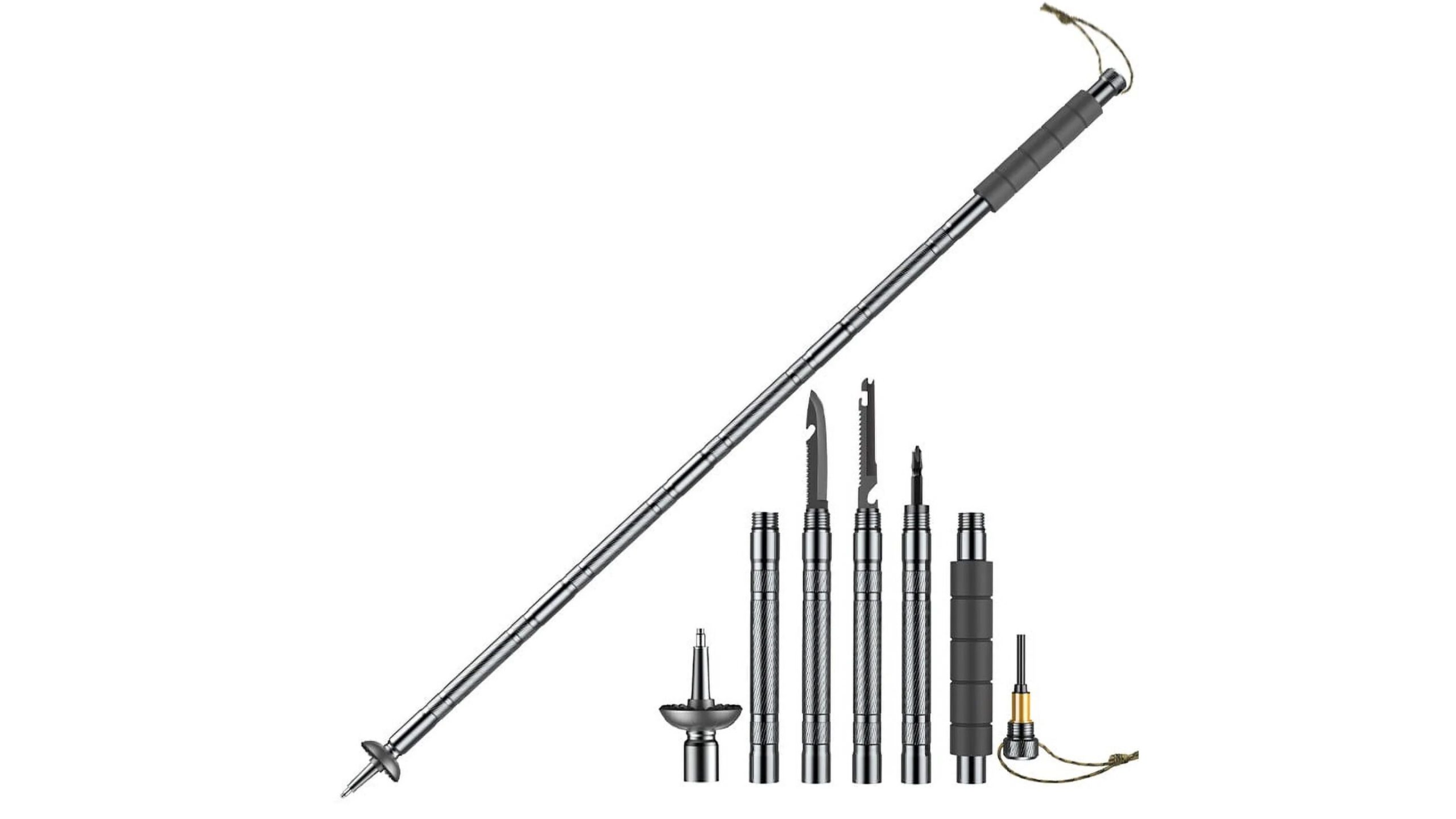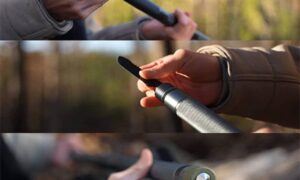My neighbor spent $180 on what he thought was a premium tactical walking stick last spring. The marketing promised military-grade construction, survival tools, and lifetime durability. Three weeks later, the thing bent during a routine hike when he put his weight on it crossing a stream. No refund, no replacement, just an expensive lesson about the difference between tactical marketing and actual tactical gear.
That experience made me dig into the tactical walking stick market, and what I found shocked me. The industry is flooded with rebranded hiking poles wrapped in military aesthetics, priced like premium gear but built like discount equipment. After months of research comparing specs, reading thousands of user experiences, and examining the best tactical walking sticks available in 2025, the gap between marketing claims and real-world performance is staggering.
Why Most “Tactical” Walking Sticks Are Just Expensive Props
Walk into any outdoor gear store or scroll through tactical equipment websites, and you’ll see the same pattern. Products labeled “military-grade,” “combat-ready,” or “tactical survival system” with price tags ranging from $150 to $250. The descriptions sound impressive until you start comparing actual specifications.
Most of these products use standard aluminum alloys you’d find in regular hiking poles. They include a handful of basic tools—often made from plastic or low-grade steel that dulls or breaks quickly. The “tactical” features amount to aggressive styling and black finishes rather than functional improvements.
The real kicker? Many of these expensive options come from the same overseas manufacturers producing budget hiking equipment. They’re literally the same poles with different branding, marked up 300% because someone added the word “tactical” to the product name.
This isn’t speculation. When you dig into Trek Staff reviews alongside reviews of premium competitors, a clear pattern emerges. Users who’ve owned multiple tactical walking sticks describe remarkably similar experiences—initial excitement about the marketing followed by disappointment when the product fails to meet basic durability standards.
What Separates Real Tactical Gear from Marketing Hype
The difference between a genuine tactical walking stick and a dressed-up hiking pole comes down to engineering choices that most marketing copy conveniently ignores.
Material composition matters more than most people realize. Aircraft-grade Aluminum 6061 T6 isn’t just a fancy term—it’s a specific alloy used in applications where failure isn’t acceptable. This material withstands substantially higher stress loads than the softer aluminum alloys found in standard hiking poles. When a manufacturer uses 6061 T6, they’re making a meaningful investment in structural integrity rather than just tossing around impressive-sounding terminology.
Load capacity separates recreational equipment from survival gear. A hiking pole that supports 180 pounds works fine for balance and occasional weight distribution. A tactical walking stick that can handle 250+ pounds becomes a legitimate survival tool you can trust when crossing unstable terrain, defending yourself, or even breaking through obstacles in emergency situations.
Tool integration reveals design priorities immediately. Adding a compass and whistle to a hiking pole doesn’t make it tactical—it makes it a hiking pole with accessories. Integrating 15 functional survival tools including glass breakers, fire starters, emergency saws, and other essential equipment transforms the stick into a comprehensive survival system. The difference is similar to comparing a Swiss Army knife to regular scissors—one provides versatility, the other serves a single purpose.
Construction method affects long-term reliability in ways that don’t show up in product photos. Reinforced stress points, proper weight distribution, and thoughtful engineering prevent catastrophic failures under extreme conditions. Cheap tactical sticks might look identical to quality options in marketing images, but the internal construction determines whether the stick performs reliably for years or bends during your first real emergency.
The Trek Staff Difference (And Why It Matters)
After examining dozens of tactical walking stick options, certain products stand out not for their marketing but for their actual construction and real-world performance.
The Trek Staff uses genuine aircraft-grade Aluminum 6061 T6 throughout its construction. This isn’t marketing fluff—you can verify the material specifications and understand why this matters for load-bearing capacity and long-term durability. The stick handles weight loads exceeding 250 pounds, which places it well above recreational hiking poles and many supposed tactical alternatives.
The integrated tool system deserves attention because it reflects thoughtful design rather than random accessory addition. Fifteen distinct survival functions built into the stick’s structure—not attached as afterthoughts but engineered as part of the overall system. Glass breaker, fire starter, emergency saw, and twelve other tools that actually function under stress rather than breaking when you need them most.
The tactical canvas carrying system enables rapid deployment in situations where fumbling with complicated mechanisms could prove dangerous. This practical consideration separates gear designed by people who understand real-world tactical needs from products created by marketing teams trying to appeal to tactical aesthetics.
Price positioning reveals interesting market dynamics. While premium tactical walking sticks command $180 to $250, and budget options hover around $40 to $60, the Trek Staff sits at $89.99. This pricing suggests either aggressive cost-cutting that compromises quality, or efficient direct-to-consumer distribution that eliminates retail markups. The construction quality and material specifications indicate the latter.
What Real Users Experience (Beyond Marketing Claims)
Filtering through thousands of user reviews across multiple platforms reveals patterns that marketing materials never mention.
Users consistently describe the Trek Staff’s weight and solidity as noticeably different from typical hiking poles. This isn’t a lightweight trekking accessory—it’s a substantial piece of equipment with genuine heft. Some people appreciate this robust construction as evidence of quality materials. Others find it heavier than expected if they’re comparing it to ultralight hiking gear. Understanding this difference helps set appropriate expectations.
The survival tools generate mixed feedback that’s worth examining. Most users praise the glass breaker and fire starter as genuinely functional. The saw and knife edges receive varied reviews—some find them adequate for emergency use, others note they’re not replacements for dedicated tools. This honest assessment matters more than blanket praise or criticism. The tools work for survival situations and backup purposes, which is their intended function.
Durability reports span years rather than months. Users describe putting serious stress on these sticks—using them for support on difficult terrain, leveraging them to move obstacles, even defending against aggressive wildlife. The consistent theme is that the stick holds up under conditions that damaged or destroyed their previous tactical equipment.
The deployment system receives particular praise from users who’ve owned other tactical walking sticks. The canvas carrying system and quick-access design let you grab and deploy the stick in seconds rather than minutes. In defensive situations or emergency scenarios where speed matters, this practical advantage justifies the product’s tactical designation.
Common Complaints and What They Actually Mean
No product is perfect, and understanding the legitimate criticisms helps you make informed decisions rather than having unrealistic expectations.
The weight issue appears frequently in reviews. At just over two pounds, the Trek Staff is noticeably heavier than ultralight hiking poles designed for long-distance trekking. If you’re counting ounces for a multi-day backpacking trip where weight is critical, this might not be your ideal choice. If you want a robust survival tool that can handle serious abuse, that weight comes from the quality materials enabling the stick’s durability.
Some users find the grip diameter larger than typical hiking poles. This design choice distributes impact force across a larger surface area, reducing hand fatigue during extended use or when using the stick defensively. People with smaller hands occasionally mention needing an adjustment period. Most adapt quickly, but it’s worth noting if you have particularly small hands.
The tool accessibility generates occasional criticism. While the integrated tools are functional, some users note that accessing certain tools requires more effort than grabbing a dedicated implement from your pack. This is accurate—the tools are emergency backups and survival functions, not primary equipment. If you’re doing serious woodworking or need precision cutting, you’ll still want proper tools. But having those backup options integrated into your walking stick could prove invaluable in unexpected situations.
How Trek Staff Compares to Premium Tactical Alternatives
Understanding the competitive landscape helps you evaluate whether you’re getting genuine value or just paying for brand names.
Autuveen’s tactical walking stick retails for $189 and claims military-grade construction. User reports and stress testing reveal it uses softer aluminum that bends under loads around 180 pounds. The stick includes five basic tools—most made from plastic that cracks or breaks with regular use. The carrying case is decent, but the fundamental engineering doesn’t justify the premium price.
Prime Adventure’s survival walking stick costs $156 and features aggressive tactical styling. The construction uses standard hiking pole materials with a black coating for aesthetic appeal. The included tools are basic and poorly integrated, feeling more like afterthought accessories than functional survival equipment. Users report the stick works fine for hiking but fails to deliver on tactical promises when subjected to real stress.
aiGear’s combat-ready walking stick commands $234 and positions itself as top-tier tactical equipment. Testing reveals the aluminum construction performs similarly to much cheaper options. The marketing emphasizes proprietary technology, but the actual specifications show standard materials and conventional design. The high price seems based on brand positioning rather than superior engineering.
Comparing these options against comprehensive reviews of the best survival walking sticks shows that price doesn’t correlate reliably with performance in this market. The expensive options often underdeliver while certain mid-priced products exceed expectations through better engineering rather than aggressive marketing.
Red Flags That Signal Overpriced Tactical Gear
Learning to spot questionable products saves you money and frustration. Certain warning signs appear consistently across tactical walking sticks that fail to deliver value.
Vague material specifications suggest manufacturers hiding behind marketing terms rather than providing verifiable information. When a product claims “military-grade aluminum” without specifying the alloy type, you’re likely looking at standard hiking pole materials with tactical branding. Legitimate manufacturers specify 6061 T6 or other precise alloy designations because the material quality is a selling point.
Impossibly low weight claims for tactical equipment indicate compromises in structural strength. Physics doesn’t allow for indestructible ultralight construction—you need material mass to handle serious stress loads. If a tactical walking stick weighs the same as recreational hiking poles but claims vastly superior strength, somebody’s lying about something.
Tool counts without quality details reveal products prioritizing quantity over functionality. Claiming “20 survival tools” sounds impressive until you discover most are low-grade components that break during real use. Five high-quality integrated tools beat fifteen cheap plastic accessories every time.
Professional product photography without actual user images raises suspicion. Legitimate products accumulate genuine user photos over time—people using the equipment in real conditions, showing wear patterns, demonstrating actual functions. Products with only studio shots and no customer images might be new to market or avoiding documentation of real-world performance.
Generic positive reviews lacking specific details suggest paid testimonials or fake feedback. Real users mention specific features, describe actual use cases, note both positives and negatives. When every review is five stars with vague praise like “great product” or “highly recommend,” you’re probably looking at manufactured credibility.
When Tactical Walking Sticks Make Sense (And When They Don’t)
Not everyone needs tactical-grade walking equipment. Understanding when these products provide genuine value versus when you’re paying for unnecessary features helps you make smart purchasing decisions.
Tactical walking sticks excel for people who hike or travel in areas where wildlife encounters, unstable terrain, or emergency situations present real possibilities. The robust construction and integrated survival tools provide legitimate safety advantages that recreational hiking poles can’t match. If you’re regularly in backcountry conditions where self-sufficiency matters, the investment makes sense.
They serve preppers and survivalists who prioritize redundant capabilities and multi-functional equipment. Having fifteen backup tools integrated into gear you’re already carrying reduces the amount of separate equipment needed while ensuring you have essential survival functions available in crisis scenarios.
They work for personal security in urban environments where defensive capabilities matter. A tactical walking stick provides a legal, non-threatening defensive tool that could prove crucial in dangerous situations. The robust construction that handles wilderness stress also handles defensive applications effectively.
They don’t make sense for ultralight backpackers counting every ounce. The durability and integrated tools come with weight that conflicts with gram-counting hiking philosophy. If minimizing pack weight is your priority, specialized lightweight trekking poles serve you better.
They’re overkill for casual day hikers on maintained trails. If you’re walking groomed paths in parks with easy access to help and facilities, you don’t need tactical-grade equipment. A basic hiking stick provides the support you need without unnecessary expense or weight.
The Truth About “Lifetime Warranties” and Money-Back Guarantees
Marketing promises about guarantees deserve scrutiny because they often contain gotchas that invalidate protection when you actually need it.
Many tactical walking stick companies advertise lifetime warranties that sound impressive until you read the fine print. Common exclusions include normal wear and tear, improper use (which they define broadly), modifications, and failure to follow maintenance requirements. The warranty might cover manufacturing defects but exclude everything else—essentially making the guarantee nearly worthless for real-world use.
Money-back guarantees require careful examination of the return process. Some companies impose restocking fees, require you to pay return shipping on heavy items, or demand the product be in “like new” condition to qualify for refunds. Others process returns smoothly but make the actual procedure difficult to navigate, banking on customers giving up rather than completing the bureaucratic requirements.
The Trek Staff’s 90-day money-back guarantee merits attention because the terms are relatively straightforward compared to many competitors. You have three months to test the product in real conditions and return it if unsatisfied. This extended trial period suggests confidence in product performance—companies don’t offer generous return policies for equipment they expect to fail quickly.
Compare this to tactical gear companies offering 30-day returns with complicated requirements, or lifetime warranties loaded with exclusions that effectively void protection for most actual use scenarios. The clearer and simpler the guarantee terms, the more likely you’re dealing with a manufacturer who stands behind their product.
Understanding What “Aircraft-Grade Aluminum” Actually Means
Marketing buzzwords like “aircraft-grade” get thrown around carelessly in tactical gear advertising. Understanding what these terms actually mean helps you evaluate whether you’re getting premium materials or just premium marketing.
Aircraft-grade aluminum isn’t a single specification—it’s a category of alloys meeting strict standards for aerospace applications. The most common aircraft-grade alloys are 6061 and 7075, with different properties for different applications. Both are substantially stronger than the aluminum alloys used in standard consumer products.
6061 T6 specifically refers to an aluminum alloy that’s been tempered to achieve particular strength characteristics. The T6 designation indicates a specific heat treatment process that maximizes the material’s strength-to-weight ratio. This alloy is used in aircraft structures, automotive frames, and applications where failure could prove catastrophic.
When a tactical walking stick specifies 6061 T6 construction, you can verify this is a legitimate premium material rather than marketing speak. The alloy costs significantly more than standard aluminum, so companies using it generally want to highlight this fact with precise specifications rather than vague claims.
Products claiming “aircraft-grade aluminum” without specifying the alloy should raise suspicion. This vague terminology lets manufacturers suggest premium materials without actually using them. If the material is genuinely high-grade, they’ll specify exactly which alloy because it’s a competitive advantage.
Real-World Testing vs. Marketing Videos
The tactical gear industry relies heavily on dramatic demonstration videos showing products withstanding extreme conditions. Understanding how these videos relate to actual performance helps you set appropriate expectations.
Professional product testing for marketing purposes occurs under controlled conditions designed to showcase maximum performance. The equipment is new, properly maintained, and used under optimal circumstances. These demonstrations show what the product can do under ideal conditions, which doesn’t always reflect real-world performance after months of regular use.
User-generated testing provides more realistic assessment of long-term durability and practical functionality. When regular people post videos or detailed reviews describing their experiences after extended use, you’re seeing how the product performs in actual conditions rather than carefully staged demonstrations.
The Trek Staff’s performance in documented user testing shows consistent results matching manufacturer claims. The stick handles serious weight loads, the integrated tools function as described, and the construction holds up under conditions that damage lesser equipment. This alignment between marketing claims and verified user experiences suggests legitimate product quality rather than overpromising.
Compare this to tactical gear where professional marketing shows impressive feats while user reports describe failures and disappointments. The gap between marketing demonstration and real-world experience signals products that underdeliver on promises.
Making an Informed Decision About Tactical Walking Sticks
After examining the tactical walking stick market extensively, certain principles guide smart purchasing decisions while avoiding expensive mistakes.
Verify material specifications rather than trusting marketing adjectives. Look for specific alloy designations like 6061 T6 rather than vague claims about military-grade or tactical construction. Precise specifications indicate manufacturers proud of their materials rather than companies hiding behind buzzwords.
Compare load capacity ratings across products to understand structural differences. A stick rated for 250+ pounds provides genuine tactical capability. Equipment barely exceeding 180 pounds is probably repurposed hiking gear regardless of tactical branding.
Evaluate tool quality and integration rather than counting features. Five robust, properly integrated tools beat fifteen cheap plastic accessories. Check user reviews specifically mentioning tool functionality under real-world conditions rather than trusting product descriptions.
Read detailed user experiences from people who’ve owned the equipment for months or years. Initial impressions tell you about first use, but long-term durability emerges over time. Look for reviews mentioning continued satisfaction after extensive use rather than just unboxing excitement.
Understand return policies and warranty terms before purchasing. Clear, generous guarantees suggest confidence in product quality. Complicated warranties loaded with exclusions signal manufacturers expecting problems and protecting themselves legally.
Checking comprehensive assessments like detailed Trek Staff reviews from consumer protection organizations helps you understand both legitimate strengths and actual limitations before spending money.
The Bottom Line on Tactical Walking Sticks
The tactical walking stick market divides clearly between legitimate survival equipment and overpriced recreational gear wrapped in military aesthetics. Understanding the difference protects you from wasting money on products that look impressive but fail when you actually need them.
Genuine tactical walking sticks use premium materials engineered to handle extreme stress, integrate functional survival tools that work under real conditions, and maintain structural integrity through years of demanding use. The construction quality, material specifications, and attention to practical functionality separate them from cheaper alternatives regardless of aggressive marketing claims.
The Trek Staff represents what’s possible when engineering priorities outweigh marketing budgets. Aircraft-grade aluminum construction, legitimate 250+ pound load capacity, fifteen integrated survival tools that function under stress, and practical deployment systems that enable rapid access in emergencies. At $89.99 with a straightforward 90-day guarantee, the value proposition makes sense for people serious about tactical preparedness rather than tactical aesthetics.
Meanwhile, premium-priced competitors charging $180 to $250 often deliver standard hiking pole performance wrapped in tactical branding. The materials don’t justify the prices, the integrated tools are afterthought accessories rather than functional survival equipment, and the construction fails under conditions the marketing claims it handles effortlessly.
For consumers willing to research specifications, verify materials, and evaluate real user experiences, tactical walking sticks offer legitimate value for wilderness activities, emergency preparedness, and personal security. For people who grab the most expensive option assuming higher prices guarantee better quality, the tactical gear market is designed to separate you from your money while delivering disappointment.
The choice comes down to understanding what you’re actually buying versus what marketing promises. Premium materials, robust construction, and functional design cost money but deliver reliability when your safety depends on equipment performance. Marketing hype, tactical aesthetics, and brand names also cost money but often fail to deliver corresponding value.
Your safety and preparedness deserve equipment that actually works rather than products that just look impressive in photos. Do the research, verify the specifications, and make informed decisions based on engineering reality rather than marketing fiction. Cross-referencing verified reviews from independent consumer protection organizations helps you distinguish legitimate tactical equipment from overpriced hiking poles wrapped in military branding.

































